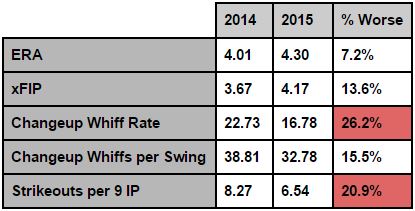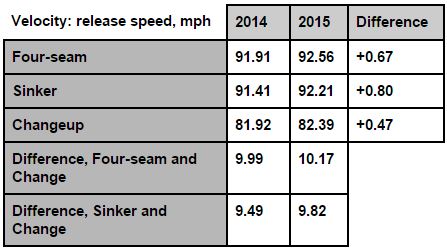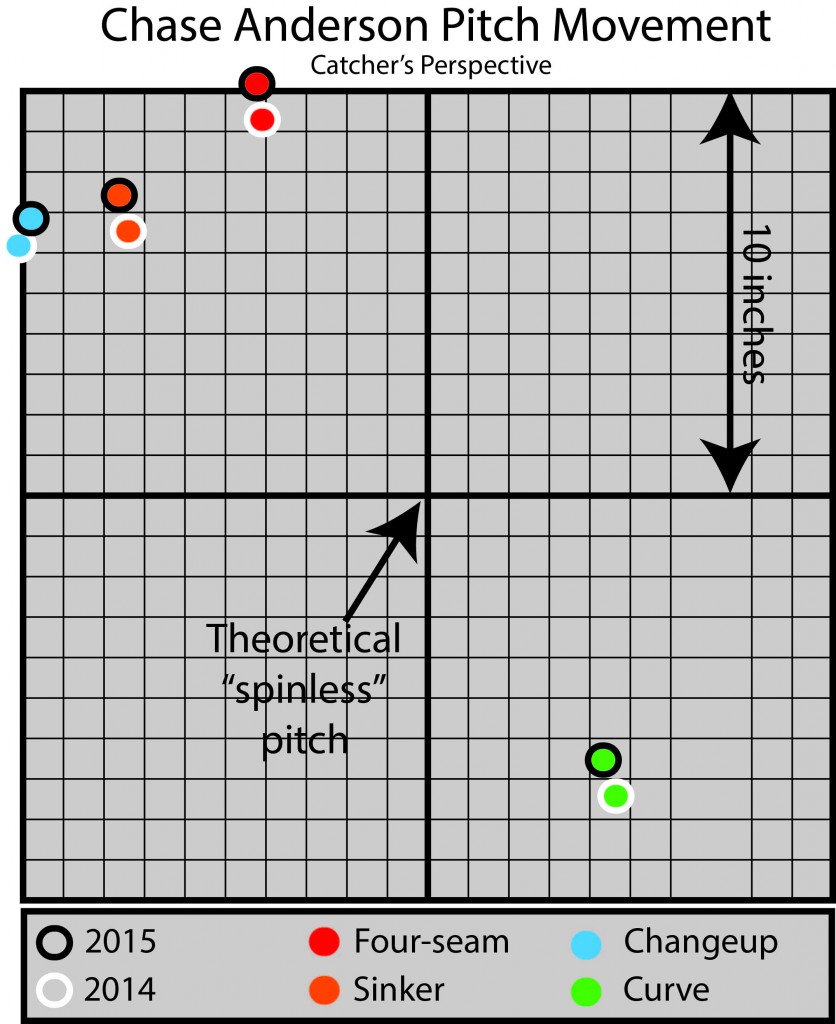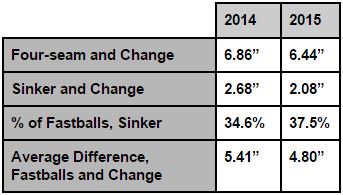Double Plus: Chase Anderson’s Dropped Drop and Whiffed Whiffs
Before 2015 became the season of grand experimentation, 2014 was quickly lost, somewhere between Sydney Cricket Grounds and Chase Field. It may not have had the same frenetic roster turnover as 2015, but 2014 was also an information-gathering season. Among the most important of that information: Chase Anderson has a silly-good changeup and major league skills. We were treated to 374 gloriously bewildering changeups of a plus plus variety, and hitters swung and missed a spectacular 22.7% of the time — and since hitters swung at them most of the time, 38.8% of swings on Anderson changeups were whiffs.
We knew that was the key to Anderson’s success, because we watch baseball and few things seemed more simple. Anderson’s other offerings seemed fringy at best. PITCHf/x Pitch Values, which give us a run value for each type of pitch as compared to major league average for those pitches, had Anderson’s four-seam worth -11.3 runs as compared to major league average, -3.3 for his sinker, and a closer-to-average -0.6 for his curve. His change, though, helped close the gap between Anderson and league average; the PITCHf/x Pitch Value for his change was 7.0.
We thought it was worthwhile to experiment with throwing more changeups, because that gap was so wide that he could still be better overall by throwing more changes, even if the effectiveness of the pitch was diminished (depending, of course, on how diminished). On a rate basis — the same PITCHf/x Pitch Values, but per 100 pitches — the gap between Anderson’s change and the average MLB change (1.85 wCH/100) was greater than the gap for his fastballs in the other direction (-1.38 for four-seam, -0.98 for sinker).
The change was good; the rest was not. Anderson ended his 114.1 innings in 2014 with a 4.01 ERA, but with a 3.67 xFIP, which is based mostly on strikeout and walk rates. Anderson was a strikeout pitcher that year, thanks to that change; a 8.27 K/9 is strong for any pitcher, even more so for a starter.
Things didn’t go as well for Anderson in 2015; the 4.30 ERA was not dramatically higher, but it was more than matched by a rise in xFIP.
In terms of slugging against, Anderson mostly improved in 2015:
Numbers in parenthesis: change in percentage usage
I think, though, that Anderson is a good example of how slugging against can’t always tell us what happened. Anderson did throw changeups more regularly in 2015, but they weren’t hit harder; they were swung at less often. The slugging percentage on Anderson’s sinker was dramatic, but no more dramatic than the slugging against for his four-seam in his better season.
It’s about the strikeouts. A 22.7% whiff rate is excellent, even for a changeup; a 16.8% whiff rate is merely good. The biggest difference was in how often batters tried to hit the changeup. In 2014, batters swung at Anderson’s change 58.6% of the time; in 2015, batters swung at it just 51.2% of the time. Still, that doesn’t account for the fact that batters made contact when they did swing at a higher rate. The plus-plus change that carried Anderson through his part of the 2014 season just wasn’t really there.
So what was different? It wasn’t that the velocity difference was smaller:
Anderson amped up a bit in 2015, maybe a little surprising given the dominant storyline for the latter half of the season that Anderson was fatigued and struggling for that reason. Maybe he was struggling because he wasn’t as fatigued? But at any rate, the increased velocity was matched with some slightly different movement.
No, the difference in movement isn’t stunning, although it bears note that while the vertical change in movement was pretty consistent pitch to pitch, the changeup and fastballs moved a bit toward each other horizontally. Still not a dramatic difference.
Consider this, though: in 2014, 34.6% of Anderson’s fastballs were sinkers, but in an effort to limit the home runs being hit off of his four-seam, that ratio ticked up to 37.5% in 2015.
Could it be that a handful of modest changes are collectively responsible for such a big drop in strikeout rate for Anderson? It looks like it might be that way.
3 Responses to Double Plus: Chase Anderson’s Dropped Drop and Whiffed Whiffs
Leave a Reply Cancel reply
Recent Posts
@ryanpmorrison
 Best part of Peralta’s 108 mph fliner over the fence, IMHO: that he got that much leverage despite scooping it out… https://t.co/ivBrl76adF, Apr 08
Best part of Peralta’s 108 mph fliner over the fence, IMHO: that he got that much leverage despite scooping it out… https://t.co/ivBrl76adF, Apr 08 RT @OutfieldGrass24: If you're bored of watching Patrick Corbin get dudes out, you can check out my latest for @TheAthleticAZ. https://t.co/k1DymgY7zO, Apr 04
RT @OutfieldGrass24: If you're bored of watching Patrick Corbin get dudes out, you can check out my latest for @TheAthleticAZ. https://t.co/k1DymgY7zO, Apr 04 Of course, they may have overtaken the league lead for outs on the bases just now, also...
But in 2017, Arizona ha… https://t.co/38MBrr2D4b, Apr 04
Of course, they may have overtaken the league lead for outs on the bases just now, also...
But in 2017, Arizona ha… https://t.co/38MBrr2D4b, Apr 04 Prior to the games today, there had only been 5 steals of 3rd this season (and no CS) in the National League. The… https://t.co/gVVL84vPQ5, Apr 04
Prior to the games today, there had only been 5 steals of 3rd this season (and no CS) in the National League. The… https://t.co/gVVL84vPQ5, Apr 04 RT @OutfieldGrass24: Patrick Corbin has a WPA of .318 and it's only the fifth inning., Apr 04
RT @OutfieldGrass24: Patrick Corbin has a WPA of .318 and it's only the fifth inning., Apr 04
Powered by: Web Designers@outfieldgrass24
 Tarik Cohen is so fast he just tackled himself, 3 hours ago
Tarik Cohen is so fast he just tackled himself, 3 hours ago RT @JCGonzalezOR: Special thanks to @HillsboroHops for hosting a LatinX community outreach and visioning session. This organization i… https://t.co/OxmEgwOpEh, Dec 08
RT @JCGonzalezOR: Special thanks to @HillsboroHops for hosting a LatinX community outreach and visioning session. This organization i… https://t.co/OxmEgwOpEh, Dec 08 Old friend alert https://t.co/xwSHU0F8Hn, Dec 08
Old friend alert https://t.co/xwSHU0F8Hn, Dec 08 Every once in a while you get a beer that's just a little off... Usually happens to me at airports., Dec 07
Every once in a while you get a beer that's just a little off... Usually happens to me at airports., Dec 07 If Pollock doesn’t sign with a team that wears red uniforms I’m going to be really disappointed. Working theory: Se… https://t.co/zHn9DqzEiD, Dec 07
If Pollock doesn’t sign with a team that wears red uniforms I’m going to be really disappointed. Working theory: Se… https://t.co/zHn9DqzEiD, Dec 07
Powered by: Web Designers










Talk about a guy with an up and down year. This what happens generally with starters that don’t pitch off their fastball. Doesn’t matter how effective the change is, third time around only the free swingers are still biting on the change.
[…] doesn’t: a ground ball bent. Re-routing Anderson toward ground balls through use of a sinker did not go so well in 2015. But Schugel doesn’t need to make any changes along those lines; he’s not as […]
[…] Chase Anderson’s batted ball profile puts him in the danger zone and the drop in strikeouts really hurt him. He’s a rotation filler and nothing more at this point. […]